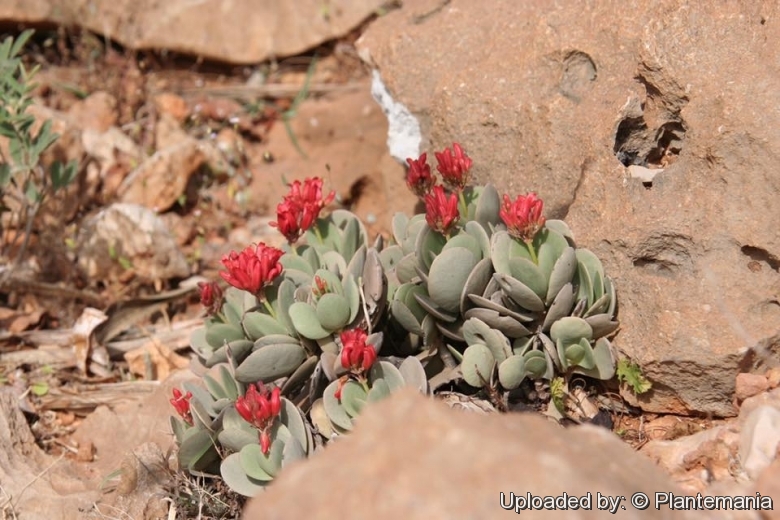




Your support is critical to our success.

Origin and Habitat: Yemen (Socotra).
Altitude range: 100–800 metes above sea level.
Habitat and Ecology: Kalanchoe farinaceaSN|27643]]SN|27643]] is common amongst rocks in succulent shrubland and drought-deciduous shrubland, mostly on limestone plains of the higher parts of island and also on granite slab. It grows in cracks in the rocks in several vegetation types often in association with Dracaena cinnabariSN|32990]]SN|32990]], Duvaliandra dioscoridisSN|29240]]SN|29240]], also Sarcostemma socotranumSN|33285]]SN|33285]], and Ceropegia spp.
Synonyms:
- Kalanchoe farinacea Balf.f.
Description: Kalanchoe farinaceaSN|27642]]SN|27643]] is a rather pretty, low growing, perennial crassulaceous plant with curious spoon-shaped foliage. It is entirely glabrous, to 30 cm tall, and produces bunches of small bloom, the lower half of the flower is yellow and the upper bright scarlet. This species is easily distinguished from all the species of Kalanchoe on Socotra by the white or whitish green stems and leaves. K. farinacea is the only long day flowering plant in the genus.
Stems: Cylindrical, erect, stout, sparingly branched, white or whitish-green.
Leaves: Clustered towards the branches tips, sessile, very thick, spreading, obovate to almost round, covered with a white to whitish-green mealy pubescence, glaucous 2-5.5 cm in length, 1.5-3.5 cm wide. Apex rounded, base wedge-shaped, margins entire and faintly rosy.
Inflorescences: Compact corymbose panicles, mealy-pubescent throughout. Pedicels 2-14 mm long. Flowers erect or spreading. Calyx tube about 1 mm long, lobes triangular, fleshy, 1-2 mm long, 1-1.5 mm wide. Corolla bright red throughout or golden yellow at the base, tube uniformly cylindrical, 10-15 mm long. Corolla-lobes ovate-oblong, acute, 4 mm long, spreading. Stamens inserted at the throat of the tube, exserted. Anthers broadly oblong. Nectaries linear-oblong, rounded at the tip, 2 mm long. Style 4 mm long.
Similar species. Kalanchoe farinaceaSN|27643]]SN|27643]] is related to Kalanchoe scapigeraSN|27643]]SN|27642]] (endemic to Angola), but different in flower colour.
Bibliography: Major references and further lectures
1) Urs Eggli “Illustrated Handbook of Succulent Plants: Crassulaceae” Springer Science & Business Media, 06 December 2012
2) William Robert Ogilvie-Grant “The Natural History of Sokotra and Abdel-Kuri: Being the Report Upon the Results of the Conjoint Expedition to These Islands in 1898-9...” Free Public Museums, Henry Young and Sons, 1903
3) Miller, A. 2004. Kalanchoe farinacea. The IUCN Red List of Threatened Species 2004: e.T44882A10949725. http://dx.doi.org/10.2305/IUCN.UK.2004.RLTS.T44882A10949725.en. Downloaded on 05 January 2017.
4)Kalanchoe farinacea in: Proceedings of the Royal Society of Edinburgh. Band 11, Edinburgh 1882, S. 512.
Cultivation and Propagation: Kalanchoe farinaceaSN|27643]]SN|27643]] is a very healthy plant, easy to culture and makes an interesting plant in any collection. It need a, keep it were is bright, sunny, warm and airy.
Potting mix: They thrive in fast draining mix nutrient poor soils consisting of equal parts of loam and sand, with pumice or lava grit added to ensure good drainage.
Exposure: Mature plants do best in full sun to partial shade.
Watering: It needs moderate watering in autumn and spring while in summer it should be watered thoroughly and allowed to dry before watering again. During winter keep them rather dry, not completely (water only when the plant starts shrivelling), but it will generally grow even in winter if given water. These plants will survive on neglect. Over-watering is the most common cause of plant failure.
Frost resistance: It prefers warm temperatures but it is hardy to 5° C for short periods.
Pest and diseases: Whilst generally disease free it can be damaged by pest insects such as aphids, mealybugs and rarely scale. Protect from snails which permanently disfigure the leaves.
Propagation: It is propagated by removal of small offsets at the base of the main plant or by leaf cuttings in May or June, (when it is warm). It grows easily roots at the end of a leaf which has fallen onto ground. New plants are ready within months.
| Your Actions | |
|---|---|
| Back to Kalanchoe index | |
| Back to Crassulaceae index | |
 |
Back to Cacti Encyclopedia index |
Privacy stantement - Terms and conditions - How to cite - About us - Feedback - Donate



